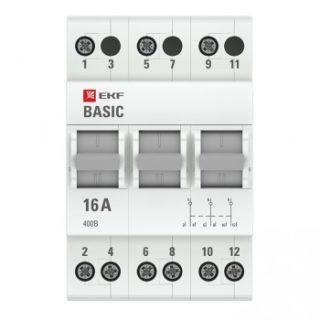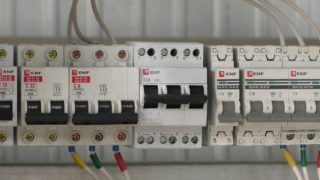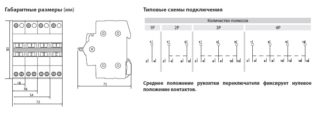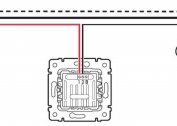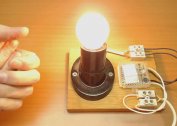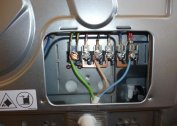Three-position switch - an electromechanical switching device used in electrical engineering to switch power to another line during overload. It is also used to conduct electric current in a normal mode and periodically turn on the electrical circuit.
Principle of operation
The 3-position switch has a handle with three positions for opening and closing the chain. The middle position provides the opening of each available group of contacts. The user controls the device manually. Upper contacts are usually used to connect inputs, and lower contacts are loads. Such a device is not equipped with trip units (thermal or electromagnetic), so when it is installed, circuit breakers operating at overload are placed on the inputs. This configuration will prevent incidents of sparking and damage to the integrity of the insulation material of the wiring. In the past, these devices were used as leading input devices in switchboards. Over time, automatic switches took this place, but the flexibility and simplicity of the design of position switches, as well as their low price, provide these products with sufficient popularity.
Varieties of Three Position Switches
3-position electric switches are available in various designs. Some models are equipped with an option to fix the switching position. They are equipped with a key lock mechanism, which excludes spontaneous transition to another position. Others who do not have this function return to their original position on their own. The design of some devices provides for the zero position - it involves the separation of all contacts.
Typically, products are manufactured with the expectation of operating in electrical networks with a nominal current rating of 25, 16 or 10 A. As for voltage, it can reach 220 V for direct current, and up to 500 for alternating current. The devices are equipped with a marking showing the power level and protection category.
The most common version is a batch mechanical 3-position switch. The control element for them is not a button, but a handle. Modern models are equipped with ergonomic handles, the design of which prevents the fingers from slipping. Products are of two types - biscuit and cam.
 The device of the biscuit switch includes plastic plates (bags) with pin leads rigidly fixed on them. Between the latter there are fiber washers for suppressing sparks, which, together with a double gap of the electric arc, allow switching high currents. There is a moving contact connected to the switching mechanism. Its position is established by turning the shaft, which provide a handle and a special spring that allows you to instantly open and close the contacts. The shaft has 3 set positions, each of which corresponds to a certain configuration of clamped or open pairs of contacts. Such a device can be used, inter alia, to connect a three-phase electric motor with the option of reverse - rotation of the rotor in a direction other than normal.
The device of the biscuit switch includes plastic plates (bags) with pin leads rigidly fixed on them. Between the latter there are fiber washers for suppressing sparks, which, together with a double gap of the electric arc, allow switching high currents. There is a moving contact connected to the switching mechanism. Its position is established by turning the shaft, which provide a handle and a special spring that allows you to instantly open and close the contacts. The shaft has 3 set positions, each of which corresponds to a certain configuration of clamped or open pairs of contacts. Such a device can be used, inter alia, to connect a three-phase electric motor with the option of reverse - rotation of the rotor in a direction other than normal.
The cam device also includes a series of packages, but arranged differently.Moving contacts are located on the outer sides of the plates connecting to the body, and static contacts are located on the inside. The first of them have the form of bridges with springs. Their position is regulated by a rod mechanism that changes position under the action of the cam. In the latter, in turn, the position is changed by means of the handle and shaft. As in the case of biscuit models, and in devices with cams, the shaft may have a different number of positions (up to eight). In three-position devices, their number is three.
The switch can be mounted on a din rail, on a wall, in a cabinet, depending on the model. Explosion-proof products are used in industries that pose a risk to human health. Most three-position switches, however, are susceptible to explosions, temperature extremes, and do not tolerate moisture. The degree of sensitivity of the device to environmental conditions can be determined by appearance: if the product is open, devoid of a protective case, it is highly sensitive, it should be installed only inside the switchboard in a room with dry air. Switches with a plastic or metal housing and touch-protected clips can also be installed outside the switchboard.
If the case is hermetically sealed, the device may be installed even in the open air. During operation, mild mechanical stress and vibration (not more than 35 Hz) are allowed.
The advantages of the devices include reliability of operation, resistance to wear and a fairly low price. They suppress arcs very quickly, but withstand a limited number of overload commutations. The weakness of these products compared to circuit breakers is also the limited capabilities as a protective device: they do not protect against short circuit incidents. Also, mechanical switches cannot be repaired: if the product has become unusable, it is dismantled with subsequent disposal, and a new one is installed in its place. They fail relatively quickly, although some manufacturers claim that the device can withstand up to half a million switching.
Household use
There are many options for using three-position switches for 220v in industry and everyday life:
- control of light and transformer substations;
- switching programs of functioning of electric welding, heating and other production equipment;
- manipulations with the modes of electric motors;
- remote control of asynchronous electric motors;
- automatic reserve input;
- switching in panel devices.
Also, these products are used to power substations, for example, in grounding structures, switching measuring devices.
How to connect
In Soviet times, the use of a three-position switch for power supply of apartment buildings was widespread and a ubiquitous phenomenon. Then they were installed in switchboards. Now instead of such devices, automatic ones are more often used. If the landlord preferred to use a three-position three-phase switch, it can be installed in front of the electricity meter leading to the switchboard so that the apartment network can be completely turned off if the need arises. Also, to enhance the protection of the network from overload or a short-circuited incident, the combined use of both devices can be recommended.
When installing the device in a private house with a modest consumption of electricity, as well as in the country, a single-phase circuit can be applied that includes the device in the home electrical network of a spare source. Indicator lamps should be placed inside the shield, indicating that the network or generator is turned on.
Wiring diagram
When purchasing cables for mounting a three-position device, it is necessary to take into account the maximum values of the operating current in the electrical circuit. If the diameter of the conductors exceeds 6 mm2, special lugs are bought for them. Less thick wires are allowed to be connected directly to the device using soldering or ring cutting.
Typical circuits suitable for a particular device, including a switch connection diagram from three different places, are given in the technical documentation attached to it. Some of the three-position products can be connected not only to 3 poles, but also to 1, 2 or 4 (the possible number of poles is indicated in the device passport). At the entrance to the apartment, the device is placed in the place of withdrawal from the common phase conductor and zero to separate the apartment line from the main highway. Installation of the circuit breaker and its subsequent adjustment is possible only when the electricity is off. Modern products designed for use in apartment panels usually require mounting on a 35 mm DIN rail. Their terminal clamps are marked with numbers, which avoids confusion during installation. After installation, the device, as well as adjacent contact connections, must be cleaned with a dry cloth at least once every 6 months, after having previously disconnected the power supply.
As a device for switching a home network, positional manual switches are often considered an obsolete device. Nevertheless, the ease of operation and installation, as well as the price provide them with some popularity so far.
